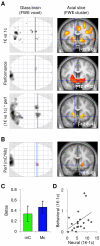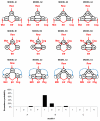Neural mechanisms underlying motivation of mental versus physical effort
- PMID: 22363208
- PMCID: PMC3283550
- DOI: 10.1371/journal.pbio.1001266
Neural mechanisms underlying motivation of mental versus physical effort
Abstract
Mental and physical efforts, such as paying attention and lifting weights, have been shown to involve different brain systems. These cognitive and motor systems, respectively, include cortical networks (prefronto-parietal and precentral regions) as well as subregions of the dorsal basal ganglia (caudate and putamen). Both systems appeared sensitive to incentive motivation: their activity increases when we work for higher rewards. Another brain system, including the ventral prefrontal cortex and the ventral basal ganglia, has been implicated in encoding expected rewards. How this motivational system drives the cognitive and motor systems remains poorly understood. More specifically, it is unclear whether cognitive and motor systems can be driven by a common motivational center or if they are driven by distinct, dedicated motivational modules. To address this issue, we used functional MRI to scan healthy participants while performing a task in which incentive motivation, cognitive, and motor demands were varied independently. We reasoned that a common motivational node should (1) represent the reward expected from effort exertion, (2) correlate with the performance attained, and (3) switch effective connectivity between cognitive and motor regions depending on task demand. The ventral striatum fulfilled all three criteria and therefore qualified as a common motivational node capable of driving both cognitive and motor regions of the dorsal striatum. Thus, we suggest that the interaction between a common motivational system and the different task-specific systems underpinning behavioral performance might occur within the basal ganglia.
Conflict of interest statement
The authors have declared that no competing interests exist.
Figures






References
-
- Berridge K. C. Motivation concepts in behavioral neuroscience. Physiol Behav. 2004;81:179–209. - PubMed
-
- Small D. M, Gitelman D, Simmons K, Bloise S. M, Parrish T, et al. Monetary incentives enhance processing in brain regions mediating top-down control of attention. Cereb Cortex. 2005;15:1855–1865. - PubMed
-
- Kouneiher F, Charron S, Koechlin E. Motivation and cognitive control in the human prefrontal cortex. Nat Neurosci. 2009;12:939–945. - PubMed
-
- Krawczyk D. C, Gazzaley A, D'Esposito M. Reward modulation of prefrontal and visual association cortex during an incentive working memory task. Brain Res. 2007;1141:168–177. - PubMed
Publication types
MeSH terms
LinkOut - more resources
Full Text Sources
Medical

